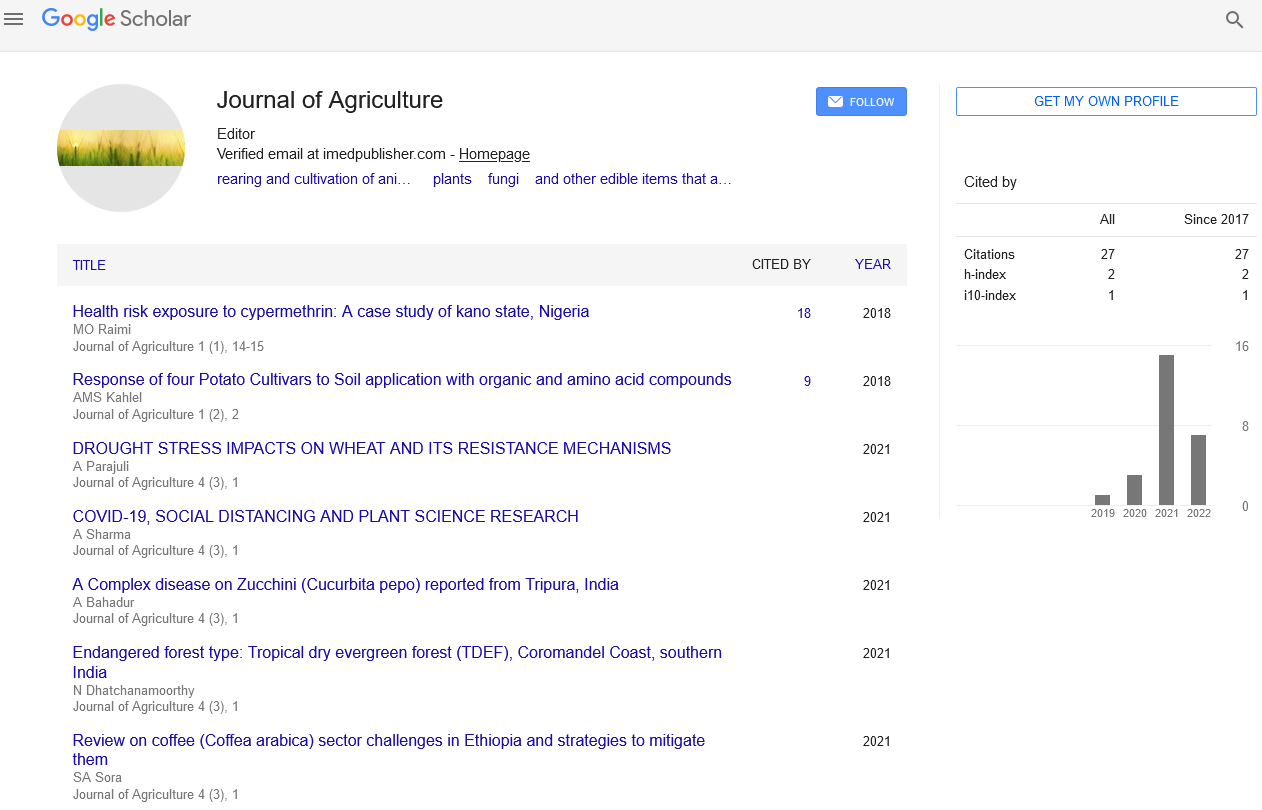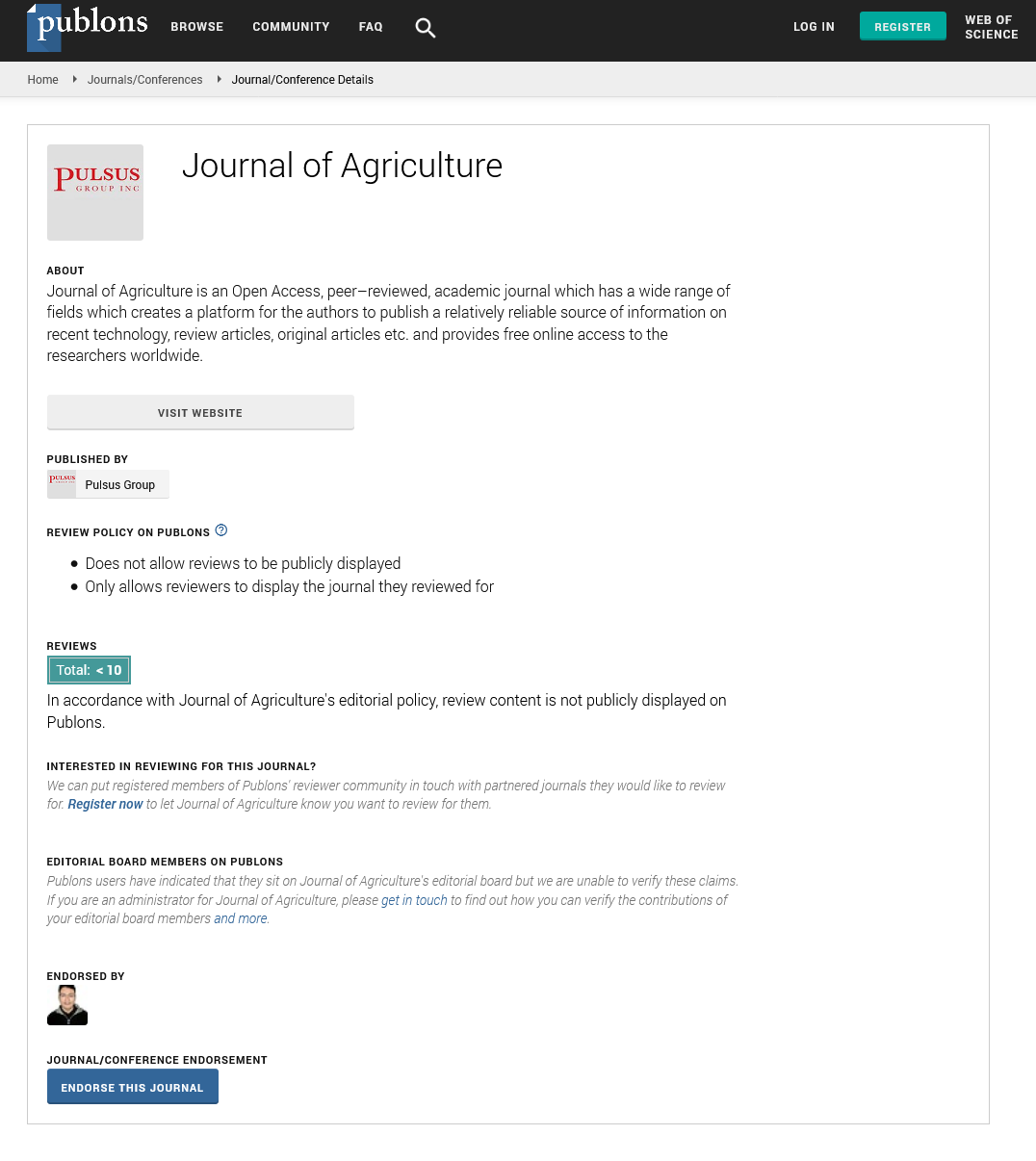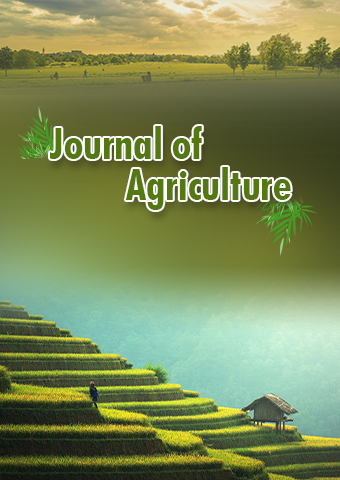Mini Review - Journal of Agriculture (2023) Volume 6, Issue 3
The Function of Agricultural Machinery in Revolutionising Agriculture
Raaz Mohon Rathod*
Department of Management Sciences, City University of Hong Kong, Hong Kong
Department of Management Sciences, City University of Hong Kong, Hong Kong
E-mail: Rmohon23@gmail.com
Received: 31-May-2023, Manuscript No. jagri-23-103202; Editor assigned: 02-Jun-2023, Pre-QC No. jagri-23-103202 (PQ); Reviewed: 16- Jun-2023, QC No. jagri-23-103202; Revised: 21-Jun-2023, Manuscript No. jagri-23-103202 (R); Published: 28-Jun-2023, DOI: 10.37532/ jagri.2023.6(3).70-72
Abstract
Agricultural machinery plays a vital role in modern farming practices by revolutionizing the way crops are cultivated, harvested, and processed. This abstract provides an overview of the significant impact of agricultural machinery on the agriculture sector, emphasizing its role in enhancing efficiency and productivity. The introduction of agricultural machinery has brought about a paradigm shift from traditional manual labor-intensive methods to mechanized operations. Mechanization has led to increased efficiency and reduced labor requirements, addressing the challenges posed by growing global population and the need for sustainable food production. The various types of agricultural machinery used in farming operations; including tractors, combine harvesters, seeders, sprayers, and irrigation systems. These machines are designed to perform specific tasks, such as land preparation, planting, crop maintenance, and harvesting, with improved precision and speed. Moreover, the integration of advanced technologies, such as GPS guidance, remote sensing, and automation, has further enhanced the capabilities of agricultural machinery. The use of machinery enables farmers to optimize inputs, such as water, fertilizers, and pesticides, leading to reduced resource wastage and environmental impact. Additionally, machinery allows for timely operations, ensuring that crops are cultivated and harvested at the optimal stages of growth, thereby enhancing yield and quality. The adoption of agricultural machinery does present certain challenges. Capital investment, maintenance, and skilled labor requirements are among the key considerations for farmers. Furthermore, the availability of machinery and related support services in rural areas, particularly in developing countries, remains a concern. Agricultural machinery has revolutionized farming practices, enabling farmers to achieve higher efficiency, productivity, and sustainability. Despite challenges, the continued development and adoption of advanced machinery, coupled with appropriate training and support, hold tremendous potential in addressing the evolving needs of the agriculture sector. Harnessing the power of agricultural machinery is crucial for meeting the increasing demand for food and ensuring global food security in the face of changing climatic conditions and growing population
Keywords
Agricultural machinery • Growing global population • Food production • Farming operations • Fertilizers • Pesticides • Food security
Introduction
Agriculture has come a long way since the days of manual labor and traditional farming techniques. The advent of agricultural machinery has brought about a significant transformation in the industry, enhancing efficiency, productivity, and sustainability. From small-scale family farms to large commercial operations, the use of advanced agricultural machinery has become indispensable. This article explores the key aspects of agricultural machinery and highlights its impact on modern-day farming.
Increasing efficiency
Agricultural machinery has revolutionized farming practices by significantly improving efficiency. Machines such as tractors, combine harvesters, and seeders have replaced human labor in various tasks, reducing the time and effort required [1]. These machines can cover large areas quickly, thereby enhancing productivity and enabling farmers to manage larger tracts of land.
Precision Agriculture
The integration of technology with agricultural machinery has given rise to the concept of precision agriculture. Modern machinery is equipped with GPS, sensors, and automation systems that enable farmers to apply inputs, such as fertilizers and pesticides, precisely where needed. This targeted approach reduces wastage, minimizes environmental impact, and optimizes crop yield [2].
Mechanized harvesting
Harvesting crops manually is a laborintensive and time-consuming process. Agricultural machinery has simplified this task by introducing mechanized harvesting equipment such as combine harvesters. These machines can efficiently cut, thresh, and clean crops, significantly reducing harvesting time and minimizing post-harvest losses [3].
Improved crop quality
Agricultural machinery plays a crucial role in maintaining and improving crop quality. Equipment like sorting machines, grading machines, and packaging systems ensure that harvested crops are sorted, cleaned, and packaged efficiently [4]. This not only enhances the overall quality of the produce but also extends its shelf life, reducing waste and increasing profitability.
Sustainable farming practices
The use of agricultural machinery has facilitated the adoption of sustainable farming practices. For instance, machinery with reduced emissions and fuel consumption promotes environmental conservation. Additionally, equipment designed for conservation tillage techniques minimizes soil erosion, improves water retention, and enhances soil health [5]. These practices contribute to long-term sustainability and help meet the growing demand for environmentally friendly agricultural practices [6].
Data-driven farming
The integration of machinery with data collection and analysis tools has led to datadriven farming. Advanced machinery can collect real-time data on soil conditions, crop health, and weather patterns. This data can be analysed to make informed decisions regarding irrigation, fertilization, and pest control, optimizing resource allocation and increasing overall farm productivity [7,8].
Farmer safety and well-being
Agricultural machinery has significantly improved farmer safety and well-being. The use of machinery in strenuous tasks reduces physical labor and minimizes the risk of injuries. Moreover, ergonomic designs and safety features incorporated into machinery enhance operator comfort and reduce the occurrence of work-related health issues [9,10].
Conclusion
Agricultural machinery has become an integral part of modern farming, revolutionizing agricultural practices and contributing to increased efficiency, productivity, and sustainability. The adoption of advanced machinery, combined with technology and data-driven approaches, has paved the way for precision agriculture and improved crop quality. As the world’s population continues to grow, the role of agricultural machinery will be crucial in meeting the global demand for food while ensuring responsible and sustainable farming practices.
References
- Nyirenda SP, Sileshi GW, Belmain SR et al. Farmers’ ethno-ecological knowledge of vegetable pests and pesticidal plant use in Northern Malawi and Eastern Zambia. Afr J Agri Res. 6, 2 (2011).
- Belmain S, Stevenson P. Ethnobotanicals in Ghana: reviving and modernising age-old farmer practice. Pesticide Outlook. 12(6), 233-238 (2001).
- Lahat G, Lazar A, Lev D et al. Sarcoma epidemiology and etiology: potential environmental and genetic factors. Surg Clin North Am. 88, 451-481 9 (2008).
- Wingren G, Fredrikson M, Brage HN et al. Soft tissue sarcoma and occupational exposures. Cancer. 66, 806-811 (1990).
- Chandalia M, Lutjohann D, von Bergmann K et al. Beneficial effects of high dietary fiber intake in patients with type 2 diabetes mellitus. N Engl J Med. 342, 1392-8 (2000).
- Booth FW, Chakravarthy MV. Physical activity and dietary intervention for chronic diseases: a quick fix after all. J Appl Physiol. 100, 1439-40 (2006).
- Pukkala E Occupation and cancer - follow-up of 15 million people in five Nordic countries. Acta Oncol. 48, 646-790 (2009).
- Wingren G, Fredrikson M, Brage HN et al. Soft tissue sarcoma and occupational exposures. Cancer. 66, 806-811 (1990).
- Anderson JW, Ward K. High-carbohydrate, high-fiber diets for insulin-treated men with diabetes mellitus. Am J Clin Nutr. 32, 2312-21 (1979).
- Roberts CK, Won D, Pruthi S et al. Effect of a short-term diet and exercise intervention on oxidative stress, inflammation, MMP-9, and monocyte chemotactic activity in men with metabolic syndrome factors. J Appl Physiol. 100: 1657-65 (2006).
- Anderson JW, Ward K. High-carbohydrate, high-fiber diets for insulin-treated men with diabetes mellitus. Am J Clin Nutr. 32, 2312-21 (1979).
Indexed at, Google Scholar, Crossref
Indexed at, Crossref, Google Scholar
Indexed at, Crossref, Google Scholar
Indexed at, Google Scholar, Crossref
Indexed at, Google Scholar, Crossref
Indexed at, Crossref, Google Scholar
Indexed at, Crossref, Google Scholar
Indexed at, Google Scholar, Crossref


